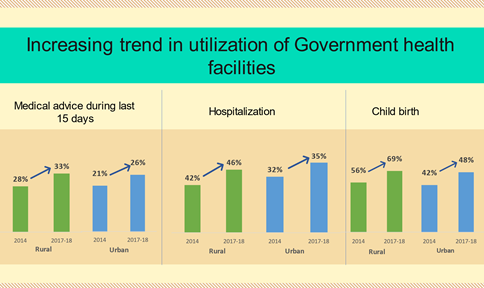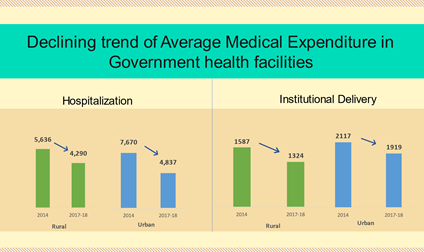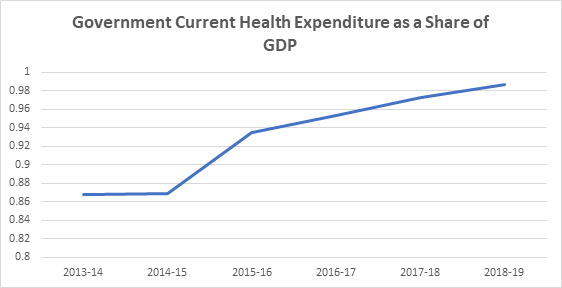Ministry of Health and Family Welfare
News report suggesting inaccuracies in National Health Accounts (NHA) estimates especially out-of-pocket expenditure reduction is misleading and inaccurate
Fall in out-of-pocket Health Spending is based on robust data of NHA 2018-19
प्रविष्टि तिथि:
07 OCT 2022 1:47PM by PIB Delhi
The news report suggesting inaccuracies in National Health Accounts (NHA) especially out-of-pocket expenditure reduction claim is misleading and incorrect. National Health Accounts (NHA) provide detailed information on expenditure incurred within the health sector of the country. These estimates are crucial as they are not only a reflection of the existing health system of the country but also enable the government to monitor the progress made in different health financing indicators.
The recent NHA estimates (2018-19) show a substantial reduction in out-of-pocket expenditure (OOPE), reaffirming the government’s commitment towards easing the citizens’ financial burden. Calling this data, a “mirage” by one expert of health economics working in a private Indian University and quoted in certain sections of Media, is devoid of justification & rational basis.
Let’s start with the questions raised on the very foundation of these estimates – National Statistical Organisation (NSO) data. The main source of information for OOPE was based on NSO data of 2017-18 whereas the previous estimates were based on 2014. Both the surveys of the 71st and 75th rounds use the same sampling design for the selection of households so that it ensures comparability of both the rounds.
Moreover the 2017-18 data was a one-year survey whereas 2014 was done over a period of six months. Given that seasonality plays an important role, the 2017-18 survey was definitely more robust than the previous survey. And, while the same experts had unequivocally accepted the 2014 data, their assessment of the 2017-18 as “doubtful” is truly arbitrary.
Such criticism is based on flawed juxtaposition and selective picking of data to further their specious argument. Formulations like, “seems problematic/seems unlikely” as basis of a claim, is nothing if not hypothetical disagreement.
The increase in utilisation of government health facilities has been another important aspect of NSO 2017-18. Study by Muraleedharan et al. (2020) published in reputed Economic and Political Weekly on these NSS rounds also observes a decline in OOPE in 2017-18.
Further, they observe this decline is driven by an increase in the use of public facilities for outpatient and inpatient services between the two NSS rounds. They also find that not only has the utilisation of public facilities increased but there has also been a decline in average OOPE in public facilities. The available evidence of NSS also show increasing trend in utilisation of government health facilities.

As per NSS, there has been an increase in utilisation of government facilities among those who took medical advice in last 15 days by almost 5%. In case of hospitalisation, this increase is around 4% in rural areas and 3% in urban areas. In case of childbirth, the share of government facilities has increased by 13% in rural areas and in urban areas it has increased by 6%.

Also, there has been a decline of more than 20 per cent in average medical expenditure in government facilities for hospitalisation. In case of institutional delivery, it has declined by 9 per cent in urban areas and 16 per cent in rural areas.
Some experts have also questioned the dip in hospitalisation rates, claiming to have found “no logical explanation” for the same. What they have failed to observe or acknowledge is the global shift from inpatient care to outpatient care, with many countries specifically designing polices to incentivise this shift.
Increase in percentage of people seeking outpatient among those who took treatment based on medical advice in last 15 days. Among those who have taken treatment based on medical advice, the share of people seeking outpatient care has increased by almost 5%. Between NSS 71st round and NSS 75th round. This increase indicates the shift towards outpatient services from inpatient services where people are substituting inpatient care with outpatient care.
The ongoing criticism of NHA 2018-19, hence, is a typical prima facie example of ignoring facts and sound reason and leaving the mantle of justification to the others.
One of the critiques in increase of government health expenditure is the inclusion of capital expenditure. Even if we look at the current health expenditure as a share of GDP, there has been a constant increase from 2013-14.

The government’s current health expenditure has been increasing constantly between 2013-14 and 2017-18. As a share of GDP, it has increased by more than 10 per cent for the same period.
****
MV
HFW/Rebuttal NHA Out of Pocket Expenditure/7th October, 2022
(रिलीज़ आईडी: 1865779)
आगंतुक पटल : 1774